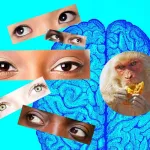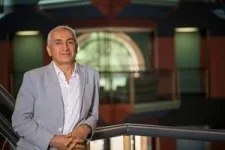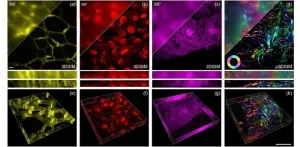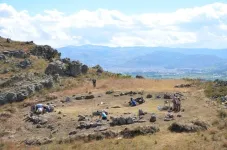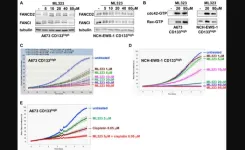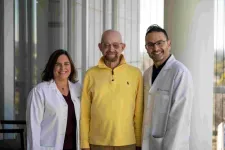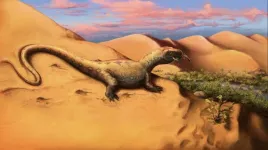(Press-News.org) HOUSTON – (Feb. 14, 2024) – Eye contact and body language are critical in social interaction, but exactly how the brain uses this information in order to inform behavior in real time is not well understood.
By combining behavioral and wireless eye tracking and neural monitoring, a team of Rice University scientists and collaborators studied how pairs of freely moving macaques interacting in a naturalistic setting use visual cues to guide complex, goal-oriented cooperative behavior. The study published in Nature offers first evidence that the part of the brain that processes visual information ⎯ the visual cortex ⎯ plays an active role in social behavior by providing an executive area ⎯ the prefrontal cortex ⎯ with the signals necessary to generate the decision to cooperate.
“We are the first to use telemetric devices to record neural activity from multiple cortical populations in the visual and prefrontal cortex while animals explore their environment and interact with one another,” said Valentin Dragoi, a professor of electrical and computer engineering at Rice and the Rosemary and Daniel J. Harrison III Presidential Distinguished Chair in Neuroprosthetics at Houston Methodist. “When primates, including humans, interact, we make eye contact and use body language to indicate to conspecifics what we want to do.
“Until now, we didn’t know how what we are looking at guides our decision to cooperate or not, because of our inability to measure oculomotor events and correlate them with what neurons are doing in that instant. Because the technology was not there, that knowledge was just unattainable.”
Most of what neuroscience has learned about the neural underpinnings of cognition originated from studies in which animals were restrained and performing a task in isolation in response to artificial stimuli on a computer screen rather than during actual interaction with peers in a more naturalistic environment. The ability to track neural activity as animals move and behave freely represents a significant step forward in neuroscience research and promises to shed new light on the inner workings of the brain.
“This has been the golden dream of neuroscientists for a long time ⎯ to record from neurons on the fly while the animal is free-moving,” said Dragoi, who also serves as scientific director of the Center for Neural Systems Restoration, a joint Houston Methodist-Rice venture dedicated to neuroscience research and treatment innovation. “We tracked populations of neurons in the visual cortex ⎯ the part of the brain that extracts information about vision ⎯ and the prefrontal cortex ⎯ an executive area that encodes our decision to carry out certain actions.”
In the experiment, two pairs of macaques were observed over the course of several weeks as they learned to work together for food reward. Each trial had the monkeys moving freely about an enclosure, separated by a clear divider. The monkeys had previously learned that pressing a button causes a snack tray to come within reach, but during trials, this only happened if the animals pressed the button simultaneously. As the macaques’ cooperation skills improved, the frequency with which they scoped out socially relevant cues ⎯ their partner, the snack tray ⎯ was found to increase prior to their acting in concert.
“This technology allows us to differentiate between active and passive vision,” Dragoi said. “Active vision is when we act on a stimulus we’re looking at with a purpose in mind. When I’m engaged in social interaction, I’m acting in some way, extracting visual information and using that information to cooperate. Our main finding is getting to see how sensory neuron populations extract information, transmit it to an executive area and how they synchronize in real time to underlie the decision to cooperate.”
Behnaam Aazhang, Rice’s J.S. Abercrombie Professor of Electrical and Computer Engineering, emphasized the critical contributions of Melissa Franch, lead author on the study, a former Ph.D. student in Dragoi’s lab and now a postdoctoral researcher at Baylor College of Medicine, and Sudha Yellapantula, a Rice doctoral alumna of Aazhang’s group who is now working as a research professional in the health care industry.
“They deserve a lot of credit,” said Aazhang, who also serves as director of the Rice Neuroengineering Initiative and co-director of the Center for Neural Systems Restoration.
“This work is very interdisciplinary and involves a complex experimental design intended to test the hypothesis that the visual frontal cortex has an important role in social behavior,” Aazhang added. “Many animals are not very social, but primates are, which was an important factor in the research, given the nature of the hypothesis.”
It turns out that expressions like “staring daggers” and “seeing eye-to-eye” are more than just a quirk of the English language: We now have evidence that the visual cortex and the prefrontal cortex work in concert to achieve complex behaviors like cooperation.
The research was supported by the National Institutes of Health (U01NS108680, 1F31MH125451).
-30-
This release can be found online at news.rice.edu.
Follow Rice News and Media Relations via Twitter @RiceUNews.
Peer-reviewed paper:
Visuo-frontal interactions during social learning in freely moving macaques | Nature | DOI: 10.1038/s41586-024-07084-x
Authors: Melissa Franch, Sudha Yellapantula, Arun Parajuli, Natasha Kharas, Anthony Wright, Behnaam Aazhang and Valentin Dragoi
https://www.nature.com/articles/s41586-024-07084-x
Image downloads:
https://news-network.rice.edu/news/files/2024/02/Nature_illustration_Pickering_02132024-4b99b14514553ed5.jpg
(Illustration by Alese Pickering/Rice University)
https://news-network.rice.edu/news/files/2024/02/240208_Dragoi_Fitlow_001-0370784cf7eb3145.jpg
CAPTION: Valentin Dragoi is a professor of electrical and computer engineering at Rice, the Rosemary and Daniel J. Harrison III Presidential Distinguished Chair in Neuroprosthetics at Houston Methodist and scientific director of the Center for Neural Systems Restoration. (Photo by Jeff Fitlow/Rice University)
https://news-network.rice.edu/news/files/2024/02/Nature_02132024_Dragoi-1911706095da6a99.jpg
CAPTION: Temporal responses of simultaneously recorded neurons in visual cortex during the perception of natural images. (Image courtesy of Valentin Dragoi/Rice University)
https://news-network.rice.edu/news/files/2024/02/190507_Behnaam_Aazhang-0016-dbd4b79b6e3de208.jpg
CAPTION: Behnaam Aazhang is Rice’s J.S. Abercrombie Professor of Electrical and Computer Engineering, director of the Rice Neuroengineering Initiative and co-director of the Center for Neural Systems Restoration. (Photo by Jeff Fitlow/Rice University)
Related stories:
Houston Methodist, Rice launch Center for Neural Systems Restoration:
https://news.rice.edu/news/2024/houston-methodist-rice-launch-center-neural-systems-restoration
Links:
Center for Neural Systems Restoration: https://centerforneuralprosthetics.org/
Rice Neuroengineering Initiative: https://neuroengineering.rice.edu/
Bioscience Research Collaborative: https://brc.rice.edu/
George R. Brown School of Engineering: https://engineering.rice.edu/
About Rice:
Located on a 300-acre forested campus in Houston, Rice University is consistently ranked among the nation’s top 20 universities by U.S. News & World Report. Rice has highly respected schools of architecture, business, continuing studies, engineering, humanities, music, natural sciences and social sciences and is home to the Baker Institute for Public Policy. With 4,574 undergraduates and 3,982 graduate students, Rice’s undergraduate student-to-faculty ratio is just under 6-to-1. Its residential college system builds close-knit communities and lifelong friendships, just one reason why Rice is ranked No. 1 for lots of race/class interaction, No. 2 for best-run colleges and No. 12 for quality of life by the Princeton Review. Rice is also rated as a best value among private universities by Kiplinger’s Personal Finance.
END
Live from the brain: Visual cues inform decision to cooperate
New technologyenables live tracking of neural activity during untethered social interaction
2024-02-14
ELSE PRESS RELEASES FROM THIS DATE:
Super-resolution microscopy harnesses digital display technology
2024-02-14
In the ever-evolving realm of microscopy, recent years have witnessed remarkable strides in both hardware and algorithms, propelling our ability to explore the infinitesimal wonders of life. However, the journey towards three-dimensional structured illumination microscopy (3DSIM) has been hampered by challenges arising from the speed and intricacy of polarization modulation.
Introducing the DMD-3DSIM System
Enter the high-speed modulation 3DSIM system “DMD-3DSIM,” combining digital display with super-resolution imaging, allowing scientists to see cellular structures in unprecedented detail. As ...
UW anthropologists’ research unveils early stone plaza in the Andes
2024-02-14
Two University of Wyoming anthropology professors have discovered one of the earliest circular plazas in Andean South America, showcasing monumental megalithic architecture, which refers to construction that uses large stones placed upright with no mortar.
Located at the Callacpuma archaeological site in the Cajamarca Basin of northern Peru, the plaza is built with large, vertically placed megalithic stones -- a construction method previously unseen in the Andes. Associate Professor Jason Toohey, project lead, and Professor Melissa Murphy have been researching ...
New epigenetic clocks reinvent how we measure age
2024-02-14
BOSTON – What causes us to age? New “clocks” developed by researchers may help point to the answers. Investigators from Brigham and Women’s Hospital, a founding member of the Mass General Brigham healthcare system, unveil a new form of epigenetic clock – a machine learning model designed to predict biological age from DNA structure. The novel model distinguishes between genetic differences that slow and accelerate aging, predicts biological age and evaluates anti-aging ...
The roles of USP1 in Ewing sarcoma
2024-02-14
“This study uncovered important roles for USP1 in Ewing sarcoma.”
BUFFALO, NY- February 14, 2024 – A new research paper was published in Genes & Cancer on February 5, 2024, entitled, “Roles of USP1 in Ewing sarcoma.”
Ewing sarcoma is a cancer of bone and soft tissue in children and young adults that is driven by the EWS-ETS fusion transcription factor, most commonly EWS-FLI1.
Researchers Panneerselvam Jayabal, Xiuye Ma and Yuzuru Shiio from The University of Texas Health Science Center previously reported that Ewing sarcoma harbors two populations of cells, ...
New algorithm disentangles intrinsic brain patterns from sensory inputs
2024-02-14
Maryam Shanechi, Dean’s Professor of Electrical and Computer Engineering and founding director of the USC Center for Neurotechnology, and her team have developed a new machine learning method that reveals surprisingly consistent intrinsic brain patterns across different subjects by disentangling these patterns from the effect of visual inputs.The work has been published in the Proceedings of the National Academy of Sciences (PNAS).
When performing various everyday movement behaviors, such as reaching for a book, our brain has to take in information, often in the form of visual input — for example, seeing where the book is. Our brain then has to process ...
A new test could predict how heart attack patients will respond to mechanical pumps
2024-02-14
Every year, around 50,000 people in the United States experience cardiogenic shock — a life-threatening condition, usually caused by a severe heart attack, in which the heart can’t pump enough blood for the body’s needs.
Many of these patients end up receiving help from a mechanical pump that can temporarily help the heart pump blood until it recovers enough to function on its own. However, in nearly half of these patients, the extra help leads to an imbalance between the left and right ventricles, which can pose danger to the patient.
In a ...
Turning back the clock on photoaging skin
2024-02-14
Chronic exposure of human skin to ultraviolet light causes premature aging, or photoaging. As the skin undergoes photoaging, type I collagen bundles, which are found in the dermis beneath the top layer of the skin and provide strength and support to skin, become fragmented. This leads to wrinkles, fragility and loss of support and elasticity.
“The best way to prevent damage to type I collagen by sunlight is to wear sunscreen consistently, daily if possible and particularly when spending time outdoors,” said Frank Wang, MD, the William B. Taylor Endowed Professor of Clinical Dermatology at U-M Medical School.
Experts ...
City of Hope research featuring the successful treatment of the oldest patient to achieve remission for leukemia and HIV published in The New England Journal of Medicine (NEJM)
2024-02-14
LOS ANGELES — City of Hope®, one of the largest cancer research and treatment organizations in the United States, treated the oldest person to be cured of a blood cancer and then achieve remission for HIV after receiving a blood stem cell transplant from a donor with a rare genetic mutation. Research published in NEJM today demonstrates that older adults with blood cancers who receive reduced intensity chemotherapy before a stem cell transplant with donor cells that are resistant to HIV may be cured of HIV infection.
Paul Edmonds, 68, of Desert Springs, California, is the fifth person in the world to achieve remission for acute myelogenous leukemia ...
A lighthouse in the Gobi desert
2024-02-14
Los Angeles, CA (February 14, 2024) — A new study published in the journal PLOS ONE explores the weight great fossil sites have on our understanding of evolutionary relationships between fossil groups—the lagerstätten effect—and for the first time, quantified the power these sites have on our understanding of evolutionary history. Surprisingly, the authors discovered that the wind-swept sand deposits of the Late Cretaceous Gobi Desert’s extraordinarily diverse and well-preserved ...
Paradigm Shift: How a risk-based program is changing health care use and outcomes for children with high-risk asthma
2024-02-14
Le Bonheur’s risk-based innovation program Changing High-Risk Asthma in Memphis through Partnership (CHAMP) significantly decreased health care use related to asthma by targeting barriers to asthma care, according to research published in the Annals of Allergy, Asthma & Immunology. After one year of enrollment in the program, results analyzing 945 children included a 48% reduction in Emergency Department (ED) visits, 68% reduction in inpatient and observation visits, 42% reduction in urgent care visits and 53% reduction in asthma exacerbations. Asthma exacerbations per patient significantly decreased from 2.97 to 1.4.
“Children ...
LAST 30 PRESS RELEASES:
Numbers in our sights affect how we perceive space
SIMJ announces global collaborative book project in commemoration of its 75th anniversary
Air pollution exposure and birth weight
Obstructive sleep apnea risk and mental health conditions among older adults
How talking slows eye movements behind the wheel
The Ceramic Society of Japan’s Oxoate Ceramics Research Association launches new international book project
Heart-brain connection: international study reveals the role of the vagus nerve in keeping the heart young
Researchers identify Rb1 as a predictive biomarker for a new therapeutic strategy in some breast cancers
Survey reveals ethical gaps slowing AI adoption in pediatric surgery
Stimulant ADHD medications work differently than thought
AI overestimates how smart people are, according to HSE economists
HSE researchers create genome-wide map of quadruplexes
Scientists boost cell "powerhouses" to burn more calories
Automatic label checking: The missing step in making reliable medical AI
Low daily alcohol intake linked to 50% heightened mouth cancer risk in India
American Meteorological Society announces Rick Spinrad as 2026 President-Elect
Biomass-based carbon capture spotlighted in newly released global climate webinar recording
Illuminating invisible nano pollutants: advanced bioimaging tracks the full journey of emerging nanoscale contaminants in living systems
How does age affect recovery from spinal cord injury?
Novel AI tool offers prognosis for patients with head and neck cancer
Fathers’ microplastic exposure tied to their children’s metabolic problems
Research validates laboratory model for studying high-grade serous ovarian cancer
SIR 2026 delivers transformative breakthroughs in minimally invasive medicine to improve patient care
Stem Cell Reports most downloaded papers of 2025 highlight the breadth and impact of stem cell research
Oxford-led study estimates NHS spends around 3% of its primary and secondary care budget on the health impacts of heat and cold in England
A researcher’s long quest leads to a smart composite breakthrough
Urban wild bees act as “microbial sensors” of city health.
New study finds where you live affects recovery after a hip fracture
Forecasting the impact of fully automated vehicle adoption on US road traffic injuries
Alcohol-related hospitalizations from 2016 to 2022
[Press-News.org] Live from the brain: Visual cues inform decision to cooperateNew technologyenables live tracking of neural activity during untethered social interaction
